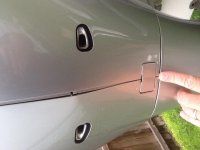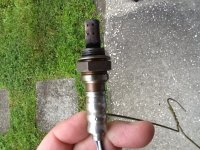I checked the oil and there is no fuel smell there. I changed the thermostats and the zincs in the manifolds within the past few months. I smelled the raw fuel from both engines. The first time was when I was in the water and I could not tell where it was coming from, so I checked the fuel lines and filters, my floscan sensors and anything else I could get to. I pulled one engine cover on the water and smelled all around the engine and did not notice any fuel smell at all. When the cover was on, I would get a whiff but could not tell where it was from. When I got the boat home, I flushed the engines and then walked around them to see if I could locate the smell. I could smell it behind the engines, but not inside the ports in the rear, or at the prop, just right at the 2" wide cover that hides the cowling bolts in the back. I noticed the same raw fuel smell on each of them but did not smell it with the covers off while checking the rear of the engine the following day. I will try to run them or prime and cycle the ignition to build pressure, then look again around all the fuel areas. I did change hp and lp filters, cleaned the bowl and replaces all the seals on anything I opened up.
The hp filters went back in the way the came out, and there was no issued getting the cover to seat without having to force it. Again, it would seem odd that both were damaged, but not impossible I suppose.
There is no fuel smell anywhere else on the boat that I can find. I have a pretty good sense of smell so I would notice that for sure. I smell the vents on the port midship hull in rough seas on occasion, but nothing else. The tank is usually full so the vents have some fumes. They are far from the engines so there is no mistaking them for what I am finding now. I have a tank to each engine with a racor filter before each engine. I have changed them recently as well, but no leaks or smells in the bilges. The boat is a cat, so that is the reason for 2 bilge areas, if you were wondering.
The engines have apprx 925hrs on them. They do seem to run a little rich. I get some black stuff on the cowlings around the ports after running it for an offshore trip. I seem to notice a little missing or slightly erratic idle at times, but they run good under load and have plenty of power. They will turn 5500+ rpm, so no issue there. I think the fuel economy could be better though. These are my first four strokes, so I am not familiar with how they "should be".
When I flush them near my shed, the exhaust smells rich and you don't want to right near the engines. I get not fuel in the water or heavy soot, the plugs burn pretty clean and the oil is not black or smell like fuel. No warning lights on the dash either. Could both O2 sensors be bad? I would think if the engines were dumping fuel, I would see that in the plugs.



